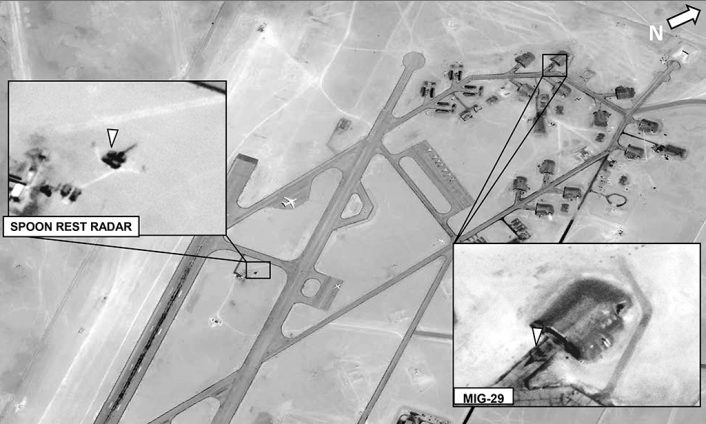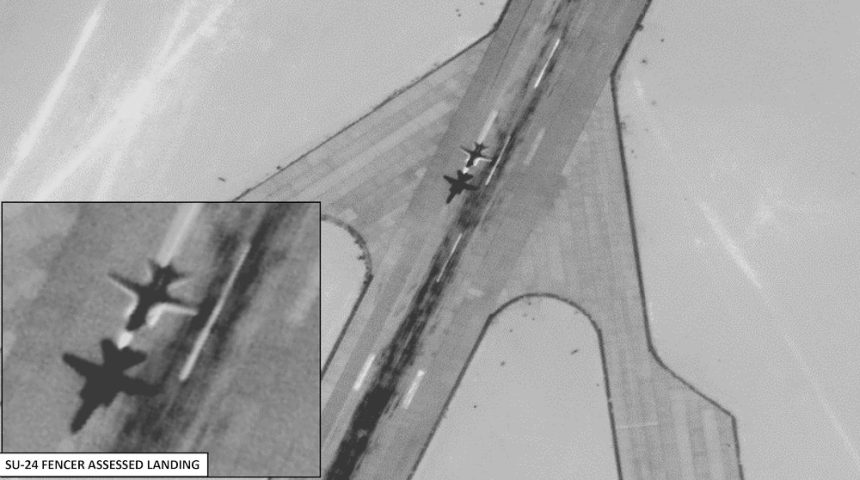Little has emerged about the operations of the MiGs and Sukhois deployed to Libya. Until US AFRICOM provided an update today.
At least 14 Russian MiG-29s and “several” Su-24s (with markings painted over) were delivered to Al Jufra airbase, in Libya over multiple days at the end of May. The transfer of the unmarked aircraft, piloted by Russian military pilots and escorted by Russian Su-35s based in Syria, took place with two stopovers: the first at Khmeimin Air Base in Syria, and the second, at an airbase in Eastern Libya, near Tobruk.
On May 26, 2020, U.S. Africa Command released the first official assessment of the deployment to Libya of the jets that had been already exposed by satellite images emerged last week. According to AFRICOM, the aircraft were deployed to support Russian state-sponsored private military contractors (PMCs) operating on the ground alongside Haftar’s LNA forces and would be flown by Russian mercenary pilots.
A second release came on the following day when AFRICOM published additional details and additional satellite images. Then, between May 28 and 29, a U.S. Navy P-8A from Sigonella operated at high altitude off the northern coast of Libya between Tripoli and Misrata, flying racetracks quite similar to those we have observed in the eastern Med off Syria: as reported in detail in an article that we have published here, this was the first time a Navy Poseidon operated so close to Libya and, while we can’t rule out the possibility the mission was completely unrelated to the deployment, there are also chances that the presence of the Poseidon in an area where this kind of aircraft has never (or rarely) operated was connected to the transfer of the Russian aircraft few days before.
In the following days little emerged from Libya about the MiGs and Sukhois until a few images, taken on the ground, confirmed the flying activity of at least one of the MiG-29s over Sirte on Jun. 10:
Photos purportedly showing an LAF Mig-29 flying over Sirte, today. #Libya pic.twitter.com/tGjF2RDxpz
— HElshelmani (@HElshelmani) June 10, 2020
Eventually, on Jun. 18, 2020, U.S. Africa Command provided a new update on the rather “shy” Russian jets in Libya:
“Russian aircraft delivered to Libya in late May are being actively flown in Libya,” says an official release that contains imagery of the jets. Read an excerpt here:
These Russian aircraft are being used to support private military companies (PMCs) sponsored by the Russian government. U.S. Africa Command (USAFRICOM) has photographic evidence of a Russian aircraft taking off from al-Jufra, Libya. A MiG-29 was also photographed operating in the vicinity of the city of Sirte, Libya.
“Russia’s sustained involvement in Libya increases the violence and delays a political solution,” said U.S. Marine Corps Brig. Gen. Bradford Gering, USAFRICOM director of operations. “Russia continues to push for a strategic foothold on NATO’s southern flank and this is at the expense of innocent Libyan lives.”
In late May, USAFRICOM reported that at least 14 MiG-29s and several Su-24s were flown from Russia to Syria, where their Russian markings were painted over to camouflage their Russian origin. These aircraft were then flown into Libya in direct violation of the United Nations arms embargo.
“We know these fighters were not already in Libya and being repaired,” said Col. Chris Karns, director of USAFRICOM public affairs. “Clearly, they came from Russia. They didn’t come from any other country.”
Russia’s introduction of manned, armed attack aircraft into Libya changes the nature of the current conflict and intensifies the potential of risk to all Libyans, especially innocent civilians.
“There is concern these Russian aircraft are being flown by inexperienced, non-state PMC mercenaries who will not adhere to international law; namely, they are not bound by the traditional laws of armed conflict,” Gering said. “If this is true and bombing occurs, innocent Libyan lives are at risk.”
As the number one arms dealer in Africa, Russia continues to profit from violence and instability across the continent. Russian government backed PMCs, such as the Wagner Group, are active in sixteen countries across Africa. It is estimated that there are about 2,000 Wagner Group personnel in Libya.
“Russia has relentlessly stuck to a narrative of implausible denials in the media,” said Karns. “It’s difficult to deny facts. Russian interference and masking of activity in Libya is visible and delaying progress. Progress the people of Libya deserve.”
Two images were released by the U.S. Africa Command. The first one, shows a Su-24 landing at an unspecified airbase.
The other shows a MiG-29 Fulcrum outside of a shelter and, quite interesting, the installation of the Spoon Rest, a mobile radar, that was probably installed to provide Early Warning and to detect possible aerial threats to the airport infrastructures and to the aircraft based there (let’s not forget Turkish UAVs have already destroyed several Russian “Pantsir” anti-aircraft systems supplied by UAE to Haftar to protect LNA bases and these drones could also be used to target the Russian MiGs at Al Jufra).










